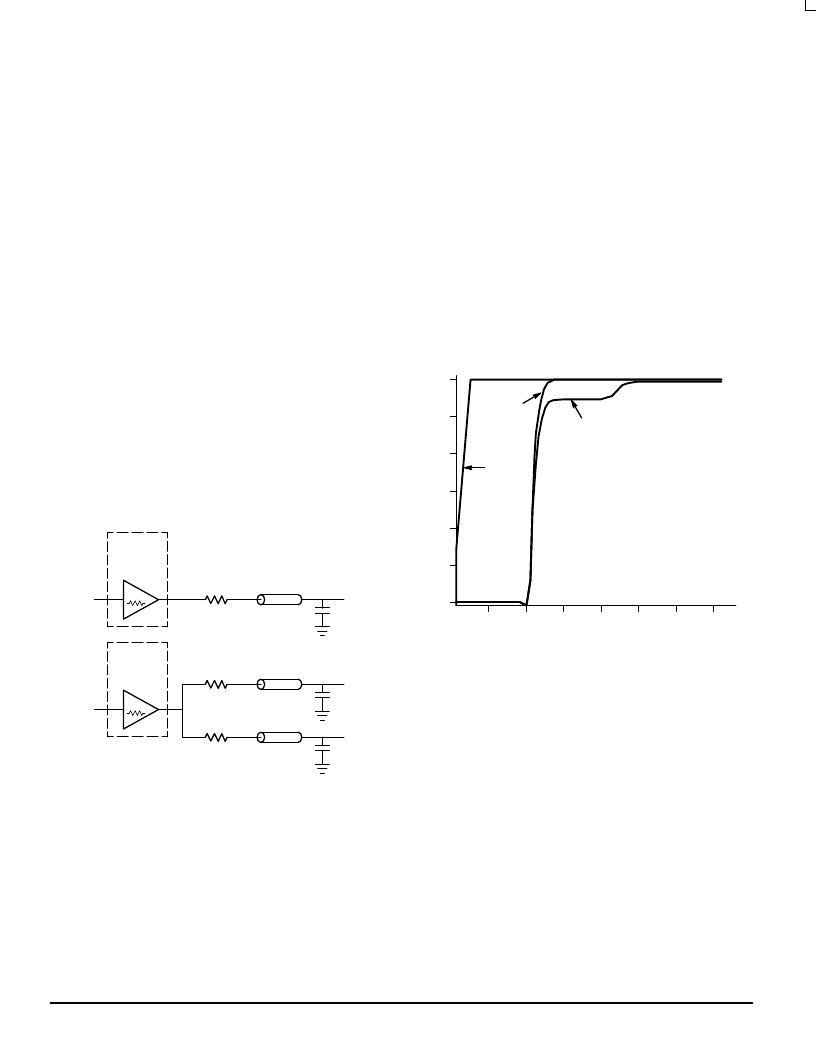- 您現(xiàn)在的位置:買賣IC網(wǎng) > PDF目錄371135 > MPC974 (Motorola, Inc.) 3.3V PLL Clock Driver(3.3V PLL時鐘驅(qū)動器) PDF資料下載
參數(shù)資料
| 型號: | MPC974 |
| 廠商: | Motorola, Inc. |
| 英文描述: | 3.3V PLL Clock Driver(3.3V PLL時鐘驅(qū)動器) |
| 中文描述: | 3.3V的PLL時鐘驅(qū)動器(3.3鎖相環(huán)時鐘驅(qū)動器) |
| 文件頁數(shù): | 6/9頁 |
| 文件大小: | 143K |
| 代理商: | MPC974 |

MPC974
MOTOROLA
TIMING SOLUTIONS
BR1333 — Rev 6
6
the voltage drop criteria. The RC filter pictured will provide a
broadband filter with approximately 100:1 attenuation for
noise whose spectral content is above 20KHz. As the noise
frequency crosses the series resonant point of an individual
capacitor it’s overall impedance begins to look inductive and
thus increases with increasing frequency. The parallel
capacitor combination shown ensures that a low impedance
path to ground exists for frequencies well above the
bandwidth of the PLL.
Although the MPC974 has several design features to
minimize the susceptibility to power supply noise (isolated
power and grounds and fully differential PLL) there still may
be applications in which overall performance is being
degraded due to system power supply noise. The power
supply filter schemes discussed in this section should be
adequate to eliminate power supply noise related problems
in most designs.
Driving Transmission Lines
The MPC974 clock driver was designed to drive high
speed signals in a terminated transmission line environment.
To provide the optimum flexibility to the user the output
drivers were designed to exhibit the lowest impedance
possible. With an output impedance of less than 10
the
drivers can drive either parallel or series terminated
transmission lines. For more information on transmission
lines the reader is referred to application note AN1091 in the
Timing Solutions brochure (BR1333/D).
Figure 5. Single versus Dual Transmission Lines
7
IN
MPC974
OUTPUT
BUFFER
RS = 43
ZO = 50
OutA
7
IN
MPC974
OUTPUT
BUFFER
RS = 43
ZO = 50
OutB0
RS = 43
ZO = 50
OutB1
In most high performance clock networks point–to–point
distribution of signals is the method of choice. In a
point–to–point scheme either series terminated or parallel
terminated transmission lines can be used. The parallel
technique terminates the signal at the end of the line with a
50
resistance to VCC/2. This technique draws a fairly high
level of DC current and thus only a single terminated line can
be driven by each output of the MPC974 clock driver. For the
series terminated case however there is no DC current draw,
thus the outputs can drive multiple series terminated lines.
Figure 5 illustrates an output driving a single series
terminated line vs two series terminated lines in parallel.
When taken to its extreme the fanout of the MPC974 clock
driver is effectively doubled due to its capability to drive
multiple lines.
The waveform plots of Figure 6 show the simulation
results of an output driving a single line vs two lines. In both
cases the drive capability of the MPC974 output buffers is
more than sufficient to drive 50
transmission lines on the
incident edge. Note from the delay measurements in the
simulations a delta of only 43ps exists between the two
differently loaded outputs. This suggests that the dual line
driving need not be used exclusively to maintain the tight
output–to–output skew of the MPC974. The output waveform
in Figure 6 shows a step in the waveform, this step is caused
by the impedance mismatch seen looking into the driver. The
parallel combination of the 43
series resistor plus the output
impedance does not match the parallel combination of the
line impedances. The voltage wave launched down the two
lines will equal:
Figure 6. Single versus Dual Waveforms
TIME (nS)
V
3.0
2.5
2.0
1.5
1.0
0.5
0
2
4
6
8
10
12
14
OutB
tD = 3.9386
OutA
tD = 3.8956
In
VL = VS ( Zo / Rs + Ro +Zo) = 3.0 (25/53.5) = 1.40V
At the load end the voltage will double, due to the near
unity reflection coefficient, to 2.8V. It will then increment
towards the quiescent 3.0V in steps separated by one round
trip delay (in this case 4.0ns).
Since this step is well above the threshold region it will not
cause any false clock triggering, however designers may be
uncomfortable with unwanted reflections on the line. To
better match the impedances when driving multiple lines the
situation in Figure 7 should be used. In this case the series
terminating resistors are reduced such that when the parallel
combination is added to the output buffer impedance the line
impedance is perfectly matched.
SPICE level output buffer models are available for
engineers who want to simulate their specific interconnect
schemes. In addition IV characteristics are in the process of
being generated to support the other board level simulators in
general use.
相關PDF資料 |
PDF描述 |
|---|---|
| MPC9774 | 3.3V / 2,5V 1:14 LVCMOS PLL CLOCK GENERATOR |
| MPC980 | Dual 3.3V PLL Clock Generator(雙3.3V PLL時鐘發(fā)生器) |
| MPC9855 | Clock Generator for PowerQUICC and PowerPC Microprocessors |
| MPC992 | Low Voltage PLL Clock Driver(低壓PLL時鐘驅(qū)動器) |
| MPC993 | Dynamic Switch PLL Clock Driver(動態(tài)開關PLL時鐘驅(qū)動器) |
相關代理商/技術參數(shù) |
參數(shù)描述 |
|---|---|
| MPC974A44 F44A WAF | 制造商:Motorola Inc 功能描述: |
| MPC9772 | 制造商:MOTOROLA 制造商全稱:Motorola, Inc 功能描述:3.3V 1:12 LVCMOS PLL Clock Generator |
| MPC9772AE | 功能描述:鎖相環(huán) - PLL 2.5 3.3V 250MHz Clock Generator RoHS:否 制造商:Silicon Labs 類型:PLL Clock Multiplier 電路數(shù)量:1 最大輸入頻率:710 MHz 最小輸入頻率:0.002 MHz 輸出頻率范圍:0.002 MHz to 808 MHz 電源電壓-最大:3.63 V 電源電壓-最小:1.71 V 最大工作溫度:+ 85 C 最小工作溫度:- 40 C 封裝 / 箱體:QFN-36 封裝:Tray |
| MPC9772AER2 | 功能描述:時鐘發(fā)生器及支持產(chǎn)品 FSL 1-12 LVCMOS PLL Clock Generator, xta RoHS:否 制造商:Silicon Labs 類型:Clock Generators 最大輸入頻率:14.318 MHz 最大輸出頻率:166 MHz 輸出端數(shù)量:16 占空比 - 最大:55 % 工作電源電壓:3.3 V 工作電源電流:1 mA 最大工作溫度:+ 85 C 安裝風格:SMD/SMT 封裝 / 箱體:QFN-56 |
| MPC9772FA | 功能描述:鎖相環(huán) - PLL 3.3V 240MHz Clock Generator RoHS:否 制造商:Silicon Labs 類型:PLL Clock Multiplier 電路數(shù)量:1 最大輸入頻率:710 MHz 最小輸入頻率:0.002 MHz 輸出頻率范圍:0.002 MHz to 808 MHz 電源電壓-最大:3.63 V 電源電壓-最小:1.71 V 最大工作溫度:+ 85 C 最小工作溫度:- 40 C 封裝 / 箱體:QFN-36 封裝:Tray |
發(fā)布緊急采購,3分鐘左右您將得到回復。